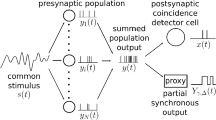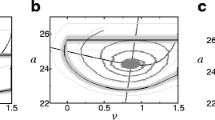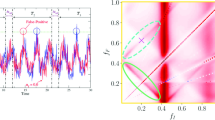Summary
Coincidence filters consist of one or more threshold elements (e.g. neurons or monostable multivibrators, extended by multiple input gates). They permit the propagation of an impulse train applied to the input only if its repetition rate does not exceed an upper and a lower boundary value. The difference between the upper and the lower boundary value may be defined as the functional bandwidth of the coincidence filter. The functional bandwidth is one of the most interesting characteristic figures of a coincidence filter. By means of this definition, the coincidence filter may be described as a device selecting quickly those impulse trains the repetition rates of which lie within the functional bandwidth
The functional bandwidth depends on the parameters of the impulse trains and of the coincidence filter. This gives rise to the question, which minimal bandwidth could be realized by coincidence filters.
On the initiation by Tischner the properties of coincidence filters operated by rectangular impulses have been investigated by Schie f and by Kosel. Rectangular impulses have the advantage, that moderate variations of the amplitudes do not disturb the coincidence. In this case however very small impulse durations are required for the realization of small bandwidth.
In the present paper the operation of coincidence filters by non rectangular impulses has been considered. Having the shape of an excitatory post-synaptic potential of motoneurons, the impulses are completely determined by the rising phase and the falling phase. These impulses have been termed short impulses in contrast to the rectangular impulses, which are long, compared to the duration of their rising and falling phases. The width of the short impulses decreases with increasing measuring level. Close to the amplitude the width becomes very small, which theoretically provides a very small functional bandwidth. The practical realization of very small functional bandwidth is heavily limited by the big variations which will be caused by minute alterations of the amplitudes as introduced by noise. The variation of the functional bandwidth caused by 1% alteration of the amplitude has been termed the error factor. In the present paper some relationships between the following four quantities have been worked out: realizable functional bandwidth, tolerable variation of functional bandwidth, error factor, and given variation of the amplitudes and thresholds (noise).
The short impulses have been piecewise approximated by analytical functions (parabolic and hyperbolic) which in general permits an analytical treatment of the problems.
Similar content being viewed by others
Literatur
Araki, T., and C. A. Terzuolo: Voltage clamp of special motoneurons. J. Neurophysiol. 25, 772–789 (1962).
Bekesy, G. v.: Zur Theorie des Hörens. Physik. Z. 30, 721–745 (1929).
Cardozo, B. L.: Frequency discrimination of the human ear. 4th Intern. Congr. Acoustics, Kopenhagen 1962.
Eccles, J. C.: The physiology of nerve cells. Baltimore: The Johns Hopkins Press 1957.
Feldtkeller, R., u. E. Zwicker: Das Ohr als Nachrichtenempfänger. Stuttgart: Hirzel 1956.
Jenik, F.: Electronic neuron models as an aid to neurophysiological research. Ergebn. Biol. 25, 206–245 (1962).
Kosel, G.: Frequenzmessung mit einem Diskriminator. Aeü 16, 359–363 (1962); 17, 358 (1963).
Küpfmüller, K.: Einschwingvorgänge in Wellenfiltern. Elektr. Nachr.-Techn. 5, 141–152 (1924); - Die Systemtheorie der elektrischen Nachrichtenübertragung. Stuttgart: Hirzel 1949; 2. Aufl. 1952; - Die nachrichtenverarbeitenden Funktionen der Nervenzellen. In: Aufnahme und Verarbeitung von Nachrichten durch Organismen. Stuttgart: Hirzel 1961.
Oetinger, R.: Die Grenzen der HÖrbarkeit von Frequenz und Tonzahländerungen bei Tonimpulsen. Aoustica 9, 430–434 (1959).
Reiss, R. F.: A theory of resonant networks. In: R. F. Reiss ed., Neural theory and modeling, p. 105–137. Stanford: Stanford University Press 1964.
Schief, R.: Koinzidenz-Siebschaltunfsn. Diss. Hannover, Techn. Hochschule 1962; - KoinzidenzIter als Modell für das menschliche Tonhöhenunterscheidungsvermögen. Kybernetik 2, H. 1, 8–15 (1963).
Takeuchi, A., and N. Takeuchi: Electrical changes in pre and postsynaptic axons of the giant synapse of Loligo. J. gen. Physiol. 45, 1181–93 (1962).
Tischner, H.: Ein Funktionsmodell der akustischen Fasern im Nervus cochlearis. Zbl. ges. Neurol. Psychiat. 158, 271 (1960).
Author information
Authors and Affiliations
Rights and permissions
About this article
Cite this article
Von Jenik, F., Adolphs, D. Koinzidenzfilter mit kurzen Impulsen. Kybernetik 2, 287–315 (1965). https://doi.org/10.1007/BF00274092
Received:
Issue Date:
DOI: https://doi.org/10.1007/BF00274092




